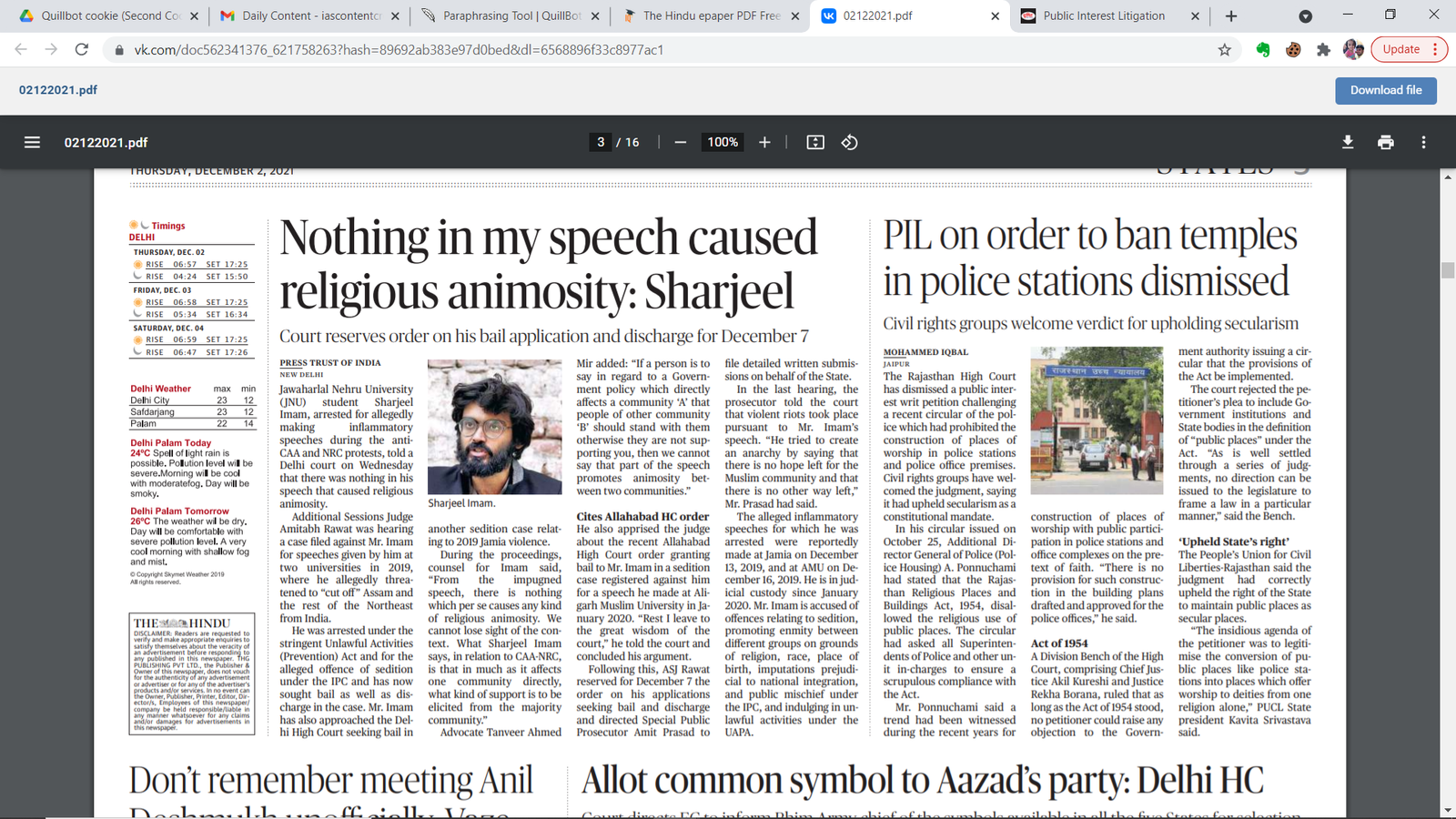
Prepare IAS Coaching
Current Affairs

Title : PUBLIC INTEREST LITIGATION: Judicial support for common man
Date : Dec 02, 2021
Description :
Based on a News Article published in the ‘The Hindu’ on 02nd December 2021 on Page Number 3
Useful for UPSC CSE Prelims and Mains (GS Paper I & II)
Introduction:
- The term 'public interest litigation' comes from American law, where it was created to provide legal representation to previously underrepresented groups such as the poor, racial minorities, unorganised consumers, and citizens concerned about environmental issues, among others.
- Public Interest Litigation (PIL) is a type of lawsuit brought in a court of law to safeguard "public interest" issues such as pollution, terrorism, road safety, and construction dangers, among others. Any issue that affects the general public's interest can be resolved by filing a Public Interest Litigation in a court of law.
- There is no definition of public interest lawsuit in any statute or act. Judges have interpreted it to mean that the intent of the general public is taken into account.
- The authority provided to the public by courts through judicial activism is known as public interest litigation. The individual making the petition, however, must demonstrate to the court that the petition is being submitted in the public interest rather than as a frivolous lawsuit by a busybody.
- Cases can be started on the petition of any public-spirited citizen, or the court might take cognizance of the subject and proceed suo motu.
The following are some of the issues that are considered in PILs:
- Cases related to bonded labour.
- Children that have been neglected
- Exploitation of casual workers and non-payment of minimum wages
- Women's atrocities
- Pollution of the environment and disruption of the ecological equilibrium
- Adulteration of food
- Heritage and cultural preservation
Some Landmark Judgements in the History of PIL in India:
- In Mumbai Kamagar Sabha vs. Abdul Thai, Justice Krishna Iyer sowed the roots of public interest litigation for the first time in India in 1976.
- Hussainara Khatoon vs. State of Bihar (1979), the first known case of PIL, focused on the inhumane circumstances of jails and under trial detainees, and resulted in the release of almost 40,000 under trial prisoners.
- The right to prompt justice arose as a key fundamental right that these detainees had been denied. In future occurrences, the same set pattern was followed.
- In the case of S.P. Gupta vs. Union of India, Justice P.N. Bhagawati ushered in a new era of the PIL movement.
- In this case, it was held that "any member of the public or social action group acting in good faith" can seek redress from the High Courts (under article 226) or the Supreme Court (under article 32) for violations of legal or constitutional rights of persons who are unable to approach the Court due to social, economic, or other disabilities.
- PIL became a powerful tool for enforcing "public duties" when executive action or misdeed resulted in public harm as a result of this decision. As a result, any Indian citizen, consumer organisation, or social action group can now approach the country's supreme court seeking legal remedies in any situation where the general public's or a segment of the public's interests are at stake.
- Justice Bhagwati went to great lengths to ensure that the notion of PILs was well-defined. He didn't care about procedural fine points, and he even considered ordinary letters from public-spirited citizens as writ petitions.
- "In an appropriate case, where the petitioner may have moved a court in her private interest and for redress of the personal grievance, the court in furtherance of Public Interest may treat it as a necessity to enquire into the state of affairs of the subject of litigation in the interest of justice," the Supreme Court held in Indian Banks' Association, Bombay & Ors. vs. M/s Devkala Consultancy Service and Ors. As a result, a case involving a private interest can equally be considered a case involving a public interest.
- Union of India vs. M.C. Mehta: A Public Interest Litigation was filed against Ganga water contamination in order to prevent further pollution of the Ganga. The Supreme Court ruled the petitioner, while not being a riparian owner, is allowed to petition the court for the execution of statutory restrictions since he is concerned for the lives of those who consume Ganga water.
- Vishaka v. Rajasthan State: Sexual harassment was recognised as a breach of Article 14, Article 15, and Article 21 of the Constitution in the case's ruling. The Sexual Harassment of Women at Workplace (Prevention, Prohibition, and Redressal) Act of 2013 was also addressed in the recommendations.
Factors Affecting the Development of PIL in India:
- The Indian Constitution's approach: Part III (Fundamental Rights) and Part IV (Directive Principles of State Policy) of India's written constitution provide a framework for regulating relations between the state and its citizens, as well as between citizens themselves.
- Whether it's linked to bonded labour, minimum salaries, land ceilings, environmental protection, or other issues, India has some of the most progressive social legislation in the world.
- This has made it simpler for courts to hold the administration accountable when it fails to uphold the law's requirements for ensuring the poor's rights.
- The court's permissive interpretation of locus standi, which allows anybody to petition the court on behalf of persons who are financially or physically unable to appear in person, has aided.
- Judges have taken suo moto action in response to newspaper stories or communications they have received.
- Although the social and economic rights set forth in Part IV of the Indian Constitution are not legally enforceable, courts have creatively interpreted them as fundamental rights, making them judicially enforceable.
- For example, Article 21's "right to life" has been broadened to encompass the right to free legal assistance, the right to live in dignity, the right to education, the right to work, the freedom from torture, the prohibition of bar fetters and hand cuffing in jails, and so on.
- To assist the poor and marginalised, judicial innovations are being implemented.
- In the Bandhua Mukti Morcha case, for example, the Supreme Court placed the burden of proof on the respondent, indicating that it would treat every incidence of forced labour as bonded labour unless the employer could prove otherwise.
- In the Asiad Workers case, Justice P.N. Bhagwati ruled that anyone earning less than the minimum wage can proceed straight to the Supreme Court, bypassing the labour commissioner and lower courts.
- Courts have created commissions to collect information on facts and bring it before the bench in PIL cases where the petitioner is unable to produce all of the relevant evidence, either because it is voluminous or because the parties are socially or economically poor.
Who Can File a PIL and Against Whom:
- A petition can be filed by any citizen to bring a public case to court:
- In the Supreme Court of India, under Article 32 of the Indian Constitution.
- In the High Court of India, under Article 226 of the Indian Constitution.
- In the Court of Magistrate, pursuant to section 133 of the Criminal Procedure Code.
- The court must be satisfied, however, that the Writ petition meets some basic requirements for PIL because the letter is addressed by an aggrieved person, a public spirited individual, or a social action group for the enforcement of legal or constitutional rights to anyone who is unable to approach the court for redress.
- A Public Interest Litigation can be brought against the State/Central Government, Municipal Authorities, or any other public entity, but not against a private party. The definition of state is the same as it is in Article 12 of the Constitution, and it includes the Government and Parliament of India, as well as the Government and Legislatures of each of the States, as well as all local and other authorities within India's territory or under the Government of India's control.
The Importance of PIL:
- The goal of PIL is to provide regular people with access to the courts in order to seek legal remedy.
- PIL is a critical tool for social transformation, preserving the rule of law, and accelerating the balance of law and justice.
- PILs were created with the intention of making justice more accessible to the poor and marginalised.
- It is a critical tool for bringing human rights to those who have been denied them.
- It ensures that everyone has access to justice. Anyone who is capable of doing so can file petitions on behalf of others who are unable or do not have the resources to do so.
- It aids judicial oversight of state institutions such as prisons, asylums, and protective homes, among others.
- It's a crucial tool for putting the concept of judicial review into practise.
- The introduction of PILs ensures increased public engagement in judicial review of administrative action.
Issues associated with PIL:
- PILs can occasionally result in an issue of competing rights.
- When a court orders the closure of a polluting industry, for example, the interests of the workers and their families who are deprived of their livelihood may not be considered by the court, thus overloading courts with spurious PILs filed by parties with vested interests.
- Today, PILs are being used for business, political, and personal benefit.
- The PIL is no longer limited to issues affecting the poor and underprivileged.
- PILs can be used to prosecute cases of judicial overreach by the judiciary in the course of resolving socioeconomic or environmental issues.
- PILs involving exploited and marginalised communities have been waiting for years.
- Due to excessive delays in the resolution of PIL cases, many leading decisions may be of academic importance only.
Conclusion:
- Public Interest Litigation has yielded incredible results that would have been impossible three decades ago.
- Through legal intervention, degraded bonded labourers, tortured under trials and women prisoners, humiliated inmates of protected women's homes, blinded convicts, exploited children, beggars, and many more have found relief.
- PIL's most significant achievement has been to increase government accountability for poor people's human rights.
- The PIL establishes a new jurisprudence of governmental accountability for constitutional and legal infractions that harm the interests of the community's weakest members.
- However, the judiciary should exercise caution when using PILs to avoid judicial overreach that violates the separation of powers principle.
- Furthermore, to keep the workload manageable, frivolous PILs with entrenched interests must be discouraged.
